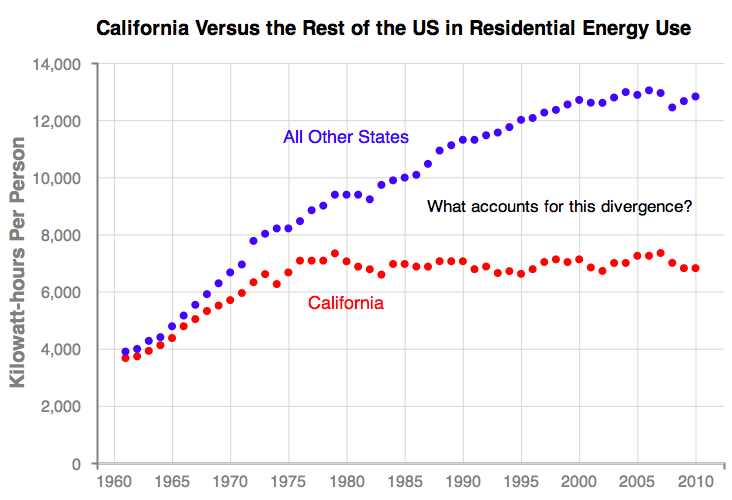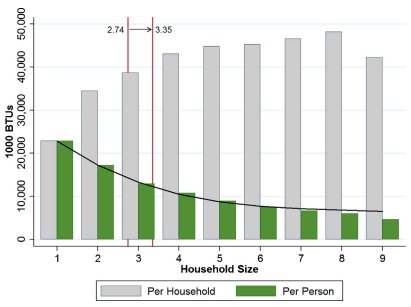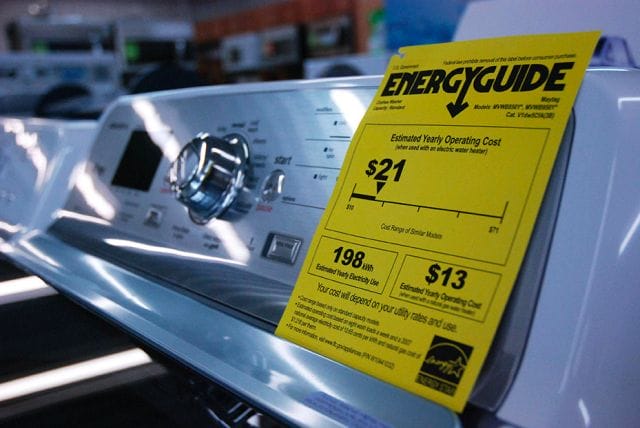
In a 2008 interview, the Nobel Prize winner in physics and future Secretary of Energy Steven Chu lauded California’s leadership in energy efficiency codes and standards. He specifically remarked on the on the state’s impressive insulation regulations and efficiency standards for appliances. Chu suggested these codes and standards “are as good or better than [those in] just about any other state.”
He followed his discussion of California’s energy regulations with the following statement:
Since the middle 1970s, California’s electricity consumption per person has remained essentially flat. The rest of the United States, excluding California, went up something on the order of 60 percent…
This is true: California’s per capita electricity consumption plateaued in 1970, while the rest of the United States saw a substantial increase. And, like many advocates of energy efficiency initiatives, Chu implied that this trend is evidence that California’s energy efficiency policies have been effective. This seems sensible. But is it true?
In his paper, “California energy efficiency: Lessons for the rest of the world, or not?”, the environmental economist Arik Levinson challenges this assumption. He suggests this relationship is a classic case of spurious correlation. “The vast majority of California’s apparent conservation relative to the rest of the country comes from coincidental features of geography and demographics,” writes Levinson.
In a subsequent paper and on the Freakonomics radio show, Levinson voiced his skepticism not just about the impact of California’s energy efficiency policies, but on energy efficiency policy more generally. From Levinson on Freakonomics:
“My paper, and others like it, provide mounting evidence that these types of regulations don’t reduce energy consumption or pollution nearly as much as promised, if even at all.”
***
Energy efficiency is seen by many as the least painful, and most politically feasible way to achieve energy conservation. Rather than actually change their consumption habits, or pay a carbon tax, people can simply use better light bulbs and more efficient air conditioners. A significant portion of President Obama’s energy policy is to “cut in half” the amount of wasted commercial and residential energy by 2030.
California has long been hailed as a leader in energy efficiency policy. In 1974, the state created the California Energy Commission, an agency that would guide energy efficiency and conservation efforts. That agency would implement some of the strictest codes and standards in the United States. Over the next ten years, rules concerning the energy efficiency of refrigerators, freezers, air conditioners, furnaces, dryers, building insulations and more were put into effect.
At just about the same time that this commission made these changes, the average residential electricity use in California began to diverge from the rest of the United States. In 1974, the per capita residential electricity consumption was approximately 7,000 kilowatt hours per person in California and 8,000 in the rest of the country. By 2010, the rest of the country had reached 12,000 kilowatt hours per person, while California’s consumption had not grown.
Naturally, the concurrence of the implementation of efficiency standards with a divergence between California and the rest of the United States led many to see a causal relationship between the two. The divergence is sometimes referred to as the “Rosenfeld effect”, after Arthur Rosenfeld, a particle physicist whose energy efficiency ideas were deeply influential to the codes and standard adopted by the California Energy Commision.
The California based energy utility PG&E claims:
“[E]nergy efficiency policies have had a significant impact on per capita electricity use, which has remained essentially constant in California over the past 30 years—a period during which per capita electricity use has nearly doubled across the U.S. as a whole.”
A Natural Resources Defense Fund report asserts that the stability of California’s energy consumption is in part “due to investment in research and development of more efficient technologies, utility programs that help customers use those tools to lower their bills, and energy efficiency standards for new buildings and appliances.”
An energy efficient washer. California has among the the strictest appliance codes and standard in the United States.
***
Arik Levinson, an Economics professor at Georgetown University, was deeply skeptical of these claims. He set out to test just how much of the difference between California and the rest of the United States could be accounted for by factors independent from codes and standards. His findings indicate that the “Rosenfeld effect” is a mirage.
Levinson demonstrates that there are three changes over the last 40 years that account for most of the difference between California and the rest of the country that have nothing to do with energy efficiency policy.
First, there is the fact that population has grown much faster in parts of the United States that typically use more electricity to power air conditioners. Since 1963, the populations of the Northeast and Midwest have grown by less than 25%, while the population in energy guzzling parts of the country like the South and Southwest have grown by over 100%. Levinson estimates that this accounts for about 15% of the Rosenfeld effect.
Second, income levels have increased across the United States. With greater wealth, Americans who live in places with extreme Winters and Summers have dedicated their extra income to heating and cooling. The mild weather in California makes spending on heating and cooling less compelling in California, so people have spent their extra income on other things. Levinson estimates this accounts for another 20% of the Rosenfeld effect.
Third and most important, Levinson’s research suggests that over 50% of the Rosenfeld effect can be accounted for by the large decrease in the number of people per home in the rest of the United States, compared to California. From 1960 to 2009, the average household size in California decreased slightly from 3.19 to 3.03 people in a home. In the rest of the country, the change was much more dramatic, with the average household size changing from 3.43 to 2.67. As the chart below from Levinson’s paper demonstrates, larger households tend to use less energy per-person than if the same number of people were living in more, smaller households.

Via Levinson
Overall, Levinson claims that these changes, which are not related to energy efficiency policy and regulations, account for almost 90% of the divergence in energy use between California and the rest of the country. The remaining 10% may be attributable to codes and standards, but it might be a result of other variables Levinson did not analyze, like price.
Many other academics, have researched the disparity between California and the rest of the country in energy usage and come to the same conclusion as Levinson. This includes Rosenfeld himself. Energy efficiency is not a primary explanation for this difference.
***
In a related paper, “How Much Energy Do Building Energy Codes Really Save?” Levinson goes even further. In it, he contends that there is little evidence that building energy efficiency standards save the amounts of energy that engineers predict. In fact, he calls into doubt the notion that they save any energy at all.
Levinson both presents original research and cites previous studies to support this claim. His work looks at whether buildings built before and after stricter buildings codes were imposed in California in 1978 use less energy, after accounting for the differences in tenant characteristics, size of home, and local weather. He finds that people living in new homes do not use less electricity.
In addition, he cites a 2012 study that studies the energy savings from a Mexican program to replace old refrigerators and air conditioners with newer, more energy efficient models. The study found that those who had their air conditioner replaced actually ended up using more energy than before (maybe because they felt less pressure to conserve). Those who only had their refrigerator replaced used less, but the savings were only a quarter of what engineers predicted.
A number of studies have found savings after less efficient technology was replaced with more efficient technology. But in most cases those savings were much less than those predicted by engineers. A 2014 study assessing the energy savings on a weatherization program in Michigan found that participation reduced energy use by 8-10%, but that these savings were 25% of what engineers predicted.
***
Why wouldn’t energy efficient technologies lead to the projected savings of engineers?
One possible explanation is the rebound effect. The rebound effect is the idea that when a commodity becomes cheaper, you consume more of it. For example, increases in fuel efficiency in cars cause people to drive more because it is cheaper. One estimate suggests a 10% improvement in fuel efficiency leads to a 2-4% increase in driving.
Energy efficient cars like the Toyota Prius lead to increased driving through the “rebound effect.”
The case of the Mexican program to replace air conditioners and refrigerators serves as a good example of when the rebound effect is strongest. Those who had their air conditioners replaced ended up using more energy than before. The researchers suspect a large part of this is that because air conditioning became relatively less expensive, households chose to use substantially increase their cooling. Houses that had their refrigerators replaced did save energy. This may be because a refrigerator is typically plugged in 24 hours a day — people literally could not use the new one any more than they were already using the old one — so the rebound effect is weak.
Another possibility is simple error in the engineering calculations. Researchers involved in the e2e project, an academic project created to assess energy efficiency results, speculate that program auditors systematically overestimate energy use before programs are implemented. This leads to consistently lower than expected gains.
***
While Levinson’s takedown of the “Rosenfeld effect” is widely accepted, his claims concerning the efficacy of efficiency codes are more controversial.
Criticisms of Levinson’s research from the National Resources Defense Council and research firm Energy Innovation suggest his work assessing California codes is deeply flawed because it only evaluates changes in electricity consumption, rather than gas usage, which is the main way Californians heat and cool their homes. Other critics believe claim the impact of codes and standard are primarily on commercial energy use, which Levinson did not assess.
Energy efficiency program defenders cite a study from economists at the University of California Berkeley suggesting California building codes save 3-5% in energy, which is not out of line with what engineers expected.
We spoke to Severin Borenstein, an economist at University of California-Berkeley, about Levinson’s research and though he agreed that Levinson should have looked at natural gas usage rather than electricity for his study, he suggested that his larger point is valid. Borenstein believes that, thus far, much of the research looking at the impact of energy efficiency programs have had “disappointing results.” Still, he pointed out that certain types of interventions, like replacing plug loads in refrigerators have had results that were more promising.
Lucas Davis, another economist and leading energy efficiency researcher, said he does not want people to “rush to judgment” about energy efficiency based on “a handful of studies.” He believes that while the supporters of energy efficiency have made overblown claims, he also thinks skeptics have been too critical. The discouraging early research results do lead him to think more focus should be put on what he calls “first best approaches” like carbon taxes or cap and trade.
***
Many policymakers think that improving the energy efficiency of our devices and appliances is a pillar of how the world will conserve energy and limit the effects of global warming. The United Nations’ Intergovernmental Panel on Climate Change (IPCC) describes energy efficiency initiatives as a “key mitigation strategy.”
Yet energy efficiency initiatives have led to perplexingly little savings compared to projections. Many researchers believe that as long as energy is cheap, substantial reductions in energy usage are unlikely to occur. In order to see the behavior change or technological innovations that would truly cause dramatic reductions in energy use, the painful reality of regulation through a carbon tax or usage cap may be necessary.
![]()
This post was written by Dan Kopf; follow him on Twitter here. To get occasional notifications when we write blog posts, please sign up for our email list.





